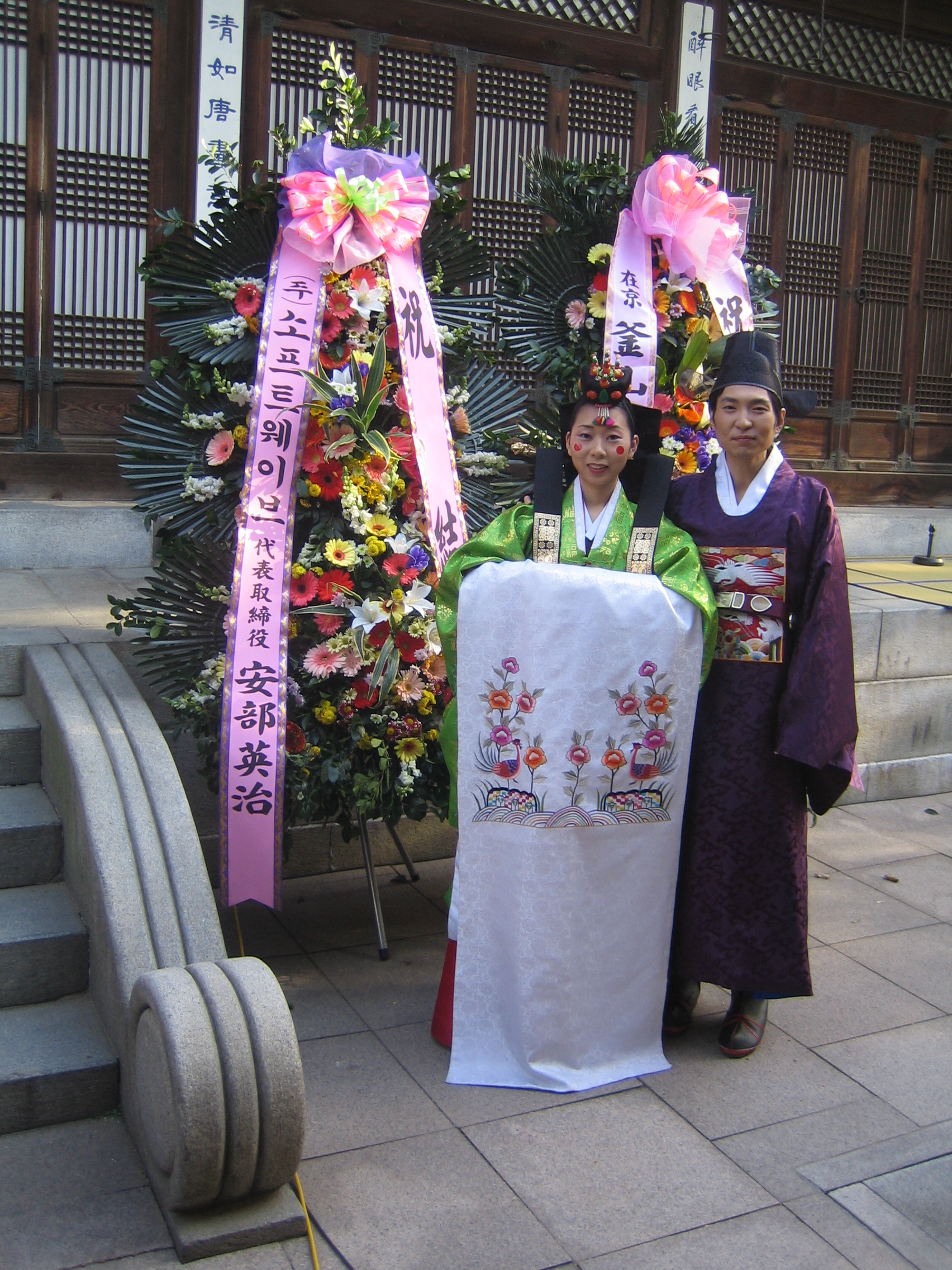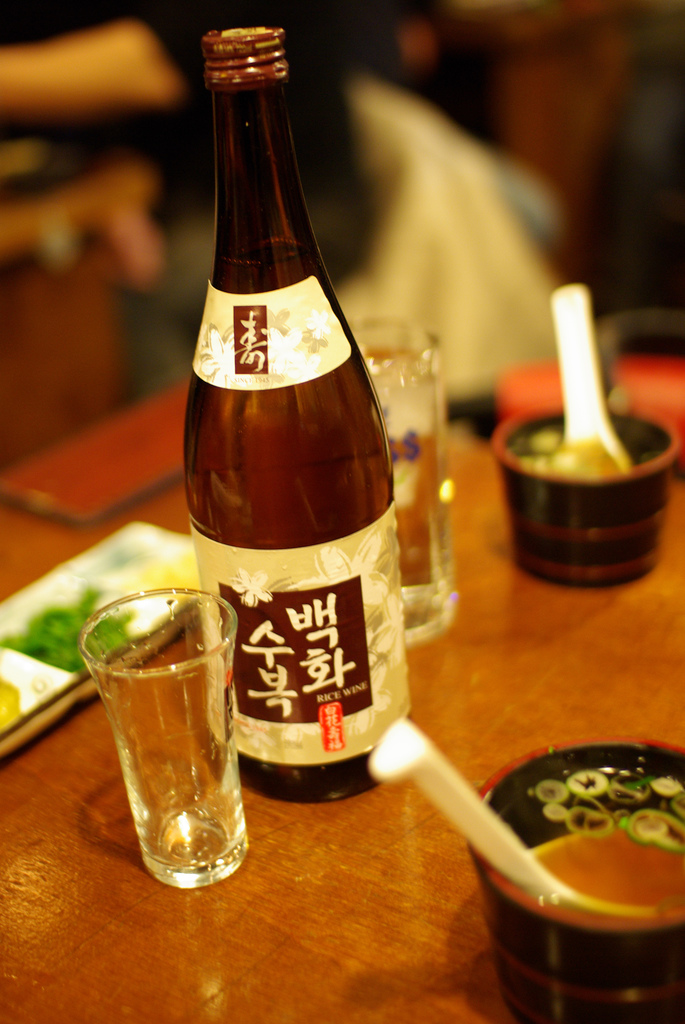|
Pyebaek
''Pyebaek'' () is a Korean wedding custom that is traditionally held a few days after the official ceremony, with only family members present. The ceremony begins with the older couple seated on cushions behind a table in front of a painted screen, with the newlyweds opposite them. The newlyweds perform a deep bow which begins standing and ends with the newlyweds pressing their foreheads to their hands while kneeling on the floor. The bride may present the groom's parents with jujubes (Korean dates) and chestnuts, which symbolize children. A variation will have the newlyweds offering cups of wine, usually ''cheongju''. The bride offers the cup to the father, and the groom offers the cup to the mother. Sometimes the parents will then also offer the newlyweds cups of ''cheongju'' or ''soju''. The older couple then shares some wisdom on marriage from their advanced experience. Finally they will throw the jujubes and chestnuts back at the bride, who has to try catching them with her ... [...More Info...] [...Related Items...] OR: [Wikipedia] [Google] [Baidu] |
Marriage In South Korea
Marriage in Korea mirrors many of the practices and expectations of marriages in other societies. Modern practices are a combination of millennia-old traditions and global influences. Marriage in pre-modern Korea The practice of matrilocality in Korea started in the Goguryeo period, continued through the Goryeo period and ended in the early Joseon period. The Korean saying that when a man gets married, he is "entering ''jangga''" (the house of his father-in-law), stems from the Goguryeo period. Marriage during the Goryeo period (918–1392) Marriages during the Goryeo period were made primarily on the basis of political and economic considerations, at least among the aristocracy. King T'aejo, the founder of the Goryeo dynasty, had 29 queens with which he built alliances with other aristocratic families. However, he married all but two of his daughters to their half brothers, rather than using them to further build and affirm alliances. A strategy continued by his successors. ... [...More Info...] [...Related Items...] OR: [Wikipedia] [Google] [Baidu] |
Jujube
Jujube (UK ; US or ), sometimes jujuba, scientific name ''Ziziphus jujuba'', and also called red date, Chinese date, and Chinese jujube, is a species in the genus '' Ziziphus'' in the buckthorn family Rhamnaceae. It is often confused with the closely related Indian jujube, '' Z.mauritiana''. The Chinese jujube enjoys a diverse range of climates from temperate to tropical, whereas the Indian jujube is restricted to warmer subtropical and tropical climates. Description It is a small deciduous tree or shrub reaching a height of , usually with thorny branches. The leaves are shiny-green, ovate-acute, long and wide, with three conspicuous veins at the base, and a finely toothed margin. The flowers are small, wide, with five inconspicuous yellowish-green petals. The fruit is an edible oval drupe deep; when immature it is smooth-green, with the consistency and taste of an apple with lower acidity, maturing brown to purplish-black, and eventually wrinkled, looking like a sma ... [...More Info...] [...Related Items...] OR: [Wikipedia] [Google] [Baidu] |
Cheongju (beverage)
''Cheongju'' (), sometimes romanized as ''Chungju'', is a clear, refined rice wine of Korean origin. Names The word ''cheongju'' () consists of two characters: ''cheong'' () meaning "clear" and ''ju'' () meaning "alcoholic drink". It contrasts with ''takju'' (), as "tak" () means "turbid". The word ''takju'' usually refers to ''makgeolli'' (milky, unrefined rice wine). The hanja characters 淸酒 are the same as the kanji pronounced ''seishu'' used on the labels of sake. The native Korean word for "clear wine", ''malgeun-sul'' (), is also used to refer to ''cheongju''. Another name for ''cheongju'' is ''yakju'' (), which literally translates into "medicinal wine". History According to '' Things on Korea''—a 12th-century book on Korea written by Song Chinese scholar Sun Mu (孫穆)—the Goryeo people used non-glutinous rice to brew rice wine. Another 12th-century Chinese book, '' Illustrated Account of Goryeo'', reports that Korean rice wine that is made with '' nuruk'' ... [...More Info...] [...Related Items...] OR: [Wikipedia] [Google] [Baidu] |
Soju
Soju (English pronunciation: ; ) is a clear and colorless distilled alcoholic beverage from Korea, traditionally made from rice, but later from other grains and has a flavor similar to vodka. It is usually consumed neat. Its alcohol content varies from about 12.5% to 53% alcohol by volume (ABV). Since 2007 low alcohol soju (below 20%) has become the most common type. Traditionally, most brands of are produced in the Andong region, but also in other regions and countries. While was traditionally made from rice, South Korean ethanol producers replace rice with other starch, such as cassava due to significantly lower capital costs. Soju often appears similar to several other East Asian liquors while differing in alcohol contents. Etymology ''Soju'' () means "burned liquor", with the first syllable, ''so'' (; 燒; "burn"), referring to the heat of distillation and the second syllable, ''ju'' (; 酒), meaning "alcoholic drink". Etymological dictionaries record that China's ... [...More Info...] [...Related Items...] OR: [Wikipedia] [Google] [Baidu] |
United States
The United States of America (USA), also known as the United States (U.S.) or America, is a country primarily located in North America. It is a federal republic of 50 U.S. state, states and a federal capital district, Washington, D.C. The 48 contiguous states border Canada to the north and Mexico to the south, with the semi-exclave of Alaska in the northwest and the archipelago of Hawaii in the Pacific Ocean. The United States asserts sovereignty over five Territories of the United States, major island territories and United States Minor Outlying Islands, various uninhabited islands in Oceania and the Caribbean. It is a megadiverse country, with the world's List of countries and dependencies by area, third-largest land area and List of countries and dependencies by population, third-largest population, exceeding 340 million. Its three Metropolitan statistical areas by population, largest metropolitan areas are New York metropolitan area, New York, Greater Los Angeles, Los Angel ... [...More Info...] [...Related Items...] OR: [Wikipedia] [Google] [Baidu] |
Bowling Green State University
Bowling Green State University (BGSU) is a Public university, public research university in Bowling Green, Ohio, United States. The main academic and residential campus is south of Toledo, Ohio. The university has nationally recognized programs and research facilities in the natural and social sciences, education, arts, business, health and wellness, humanities and applied technologies. The institution was granted a charter in 1910 as a normal school, specializing in teacher training and education. The university has developed from a small rural normal school into a comprehensive public research university. It is a part of the University System of Ohio and is currently Carnegie Classification of Institutions of Higher Education, classified as R2: Doctoral Universities with list of research universities in the United States, high research activity. In 2019, Bowling Green offered over 200 undergraduate programs, as well as master's and doctoral degrees through eight academic co ... [...More Info...] [...Related Items...] OR: [Wikipedia] [Google] [Baidu] |
Acculturation
Acculturation refers to the psychological, social, and cultural transformation that takes place through direct contact between two cultures, wherein one or both engage in adapting to dominant cultural influences without compromising their essential distinctiveness. It occurs when an individual acquires, adopts, or adjusts to a new cultural environment as a result of being placed into another culture or when another culture is brought into contact. This balancing process can result in a mixed society with prevailing and blended features or with splintered cultural changes, depending on the sociopolitical atmosphere. Individuals from other cultures work toward fitting into a more prevalent culture by selectively integrating aspects of the dominant culture, such as its Cultural trait, cultural traits and Social norm, social norms, while still holding onto their original cultural values and traditions. The impacts of acculturation are experienced differently at various levels by both ... [...More Info...] [...Related Items...] OR: [Wikipedia] [Google] [Baidu] |
Racial Integration
Racial integration, or simply integration, includes desegregation (the process of ending systematic racial segregation), leveling barriers to association, creating equal opportunity regardless of Race (classification of human beings), race, and the development of a culture that draws on diverse traditions, rather than merely bringing a racial minority group, minority into the majority culture. Desegregation is largely a legal matter, integration largely a social one. Distinguishing ''integration'' from ''desegregation'' Morris J. MacGregor Jr. in his paper "Integration of the Armed Forces 1940–1969", writes concerning the words ''integration'' and ''desegregation'': In recent years many historians have come to distinguish between these like-sounding words... The movement toward desegregation, breaking down the nation's Jim Crow laws, Jim Crow system, became increasingly popular in the decade after World War II. Integration, on the other hand, Professor Oscar Handlin maintains, ... [...More Info...] [...Related Items...] OR: [Wikipedia] [Google] [Baidu] |
Korean Americans
Korean Americans () are Americans of full or partial Korean ethnicity, Korean ethnic descent. While the broader term Overseas Korean in America () may refer to all ethnic Koreans residing in the United States, the specific designation of Korean American implies the holding of Citizenship of the United States, American citizenship. As of 2022, there are 1.5–1.8 million Americans of Korean descent, of whom roughly 1.04 million were born abroad, accounting for 8% of all Asian Americans and 0.5% of the total U.S. population. However, prominent scholars and Korean associations claim that the Korean American population exceeds 2.5–3 million, which would make it the largest community Korean diaspora, Overseas Koreans in the world, ahead of China's Koreans in China, 2.1 million. The vast majority of Korean Americans trace their ancestry to South Korea (Republic of Korea), with North Korea (Democratic People's Republic of Korea) North Korean immigration to the United States, accou ... [...More Info...] [...Related Items...] OR: [Wikipedia] [Google] [Baidu] |
Koreans
Koreans are an East Asian ethnic group native to the Korean Peninsula. The majority of Koreans live in the two Korean sovereign states of North and South Korea, which are collectively referred to as Korea. As of 2021, an estimated 7.3 million ethnic Korean diaspora, Koreans resided outside of Korea. Koreans are also an officially recognised ethnic minority in other several Continental and East Asian countries, including Koreans in China, China, Koreans in Japan, Japan, Koryo-saram, Kazakhstan, Koryo-saram, Russia, and Koryo-saram, Uzbekistan. Outside of Continental and East Asia, sizeable Korean communities have formed in Koreans in Germany, Germany, the British Koreans, United Kingdom, Koreans in France, France, the Korean Americans, United States, Korean Canadians, Canada, Korean Australians, Australia, and Korean New Zealanders, New Zealand. Etymology South Koreans refer to themselves as ''Hanguk-in'' or ''Hanguk-saram'', both of which mean "people of the Han". The ... [...More Info...] [...Related Items...] OR: [Wikipedia] [Google] [Baidu] |






